Project Management Analysis: Hershey's ERP System Implementation
VerifiedAdded on 2023/06/15
|19
|5844
|417
Report
AI Summary
This report analyzes the failed ERP system implementation at Hershey, a significant case study in project management. The failure, resulting in substantial financial losses and market share decline, stemmed from several factors, including rushed timelines, inadequate testing, and a lack of understanding of project scope by upper management. The company's inexperience with large-scale software implementations and unrealistic deadlines further contributed to the system's failure. The report examines the control systems used (or not used effectively), the reasons for cost and time overruns, the responsibilities of the project execution team, and the relationship between identified problems and stakeholder needs. It also discusses the role of the project management team in controlling the project and its stakeholders to increase the chances of successful delivery. The analysis provides valuable insights into the complexities of ERP implementations and the importance of thorough planning, realistic timelines, and effective stakeholder management. Desklib offers a range of resources, including past papers and solved assignments, to support students in their academic endeavors.
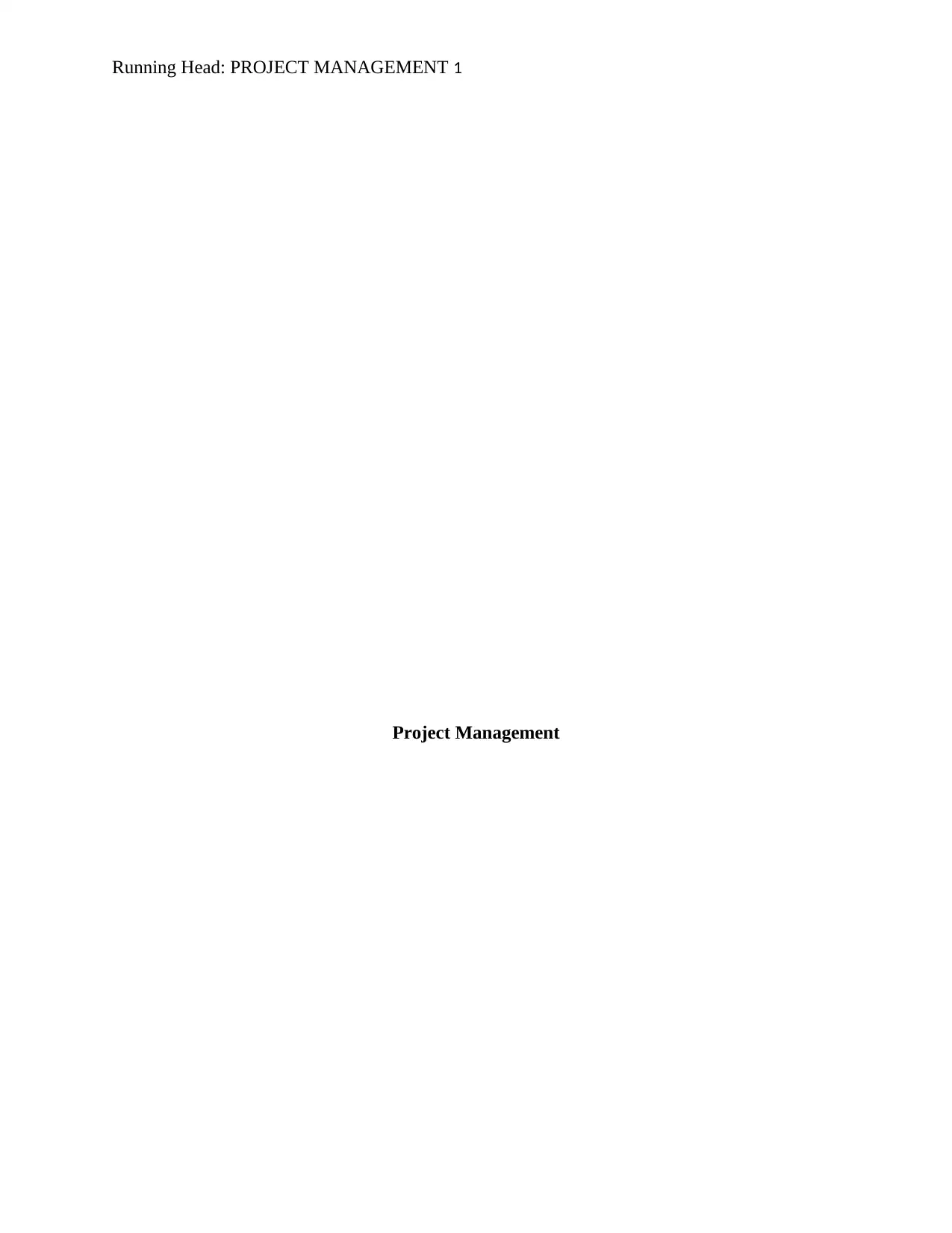
Running Head: PROJECT MANAGEMENT 1
Project Management
Project Management
Paraphrase This Document
Need a fresh take? Get an instant paraphrase of this document with our AI Paraphraser
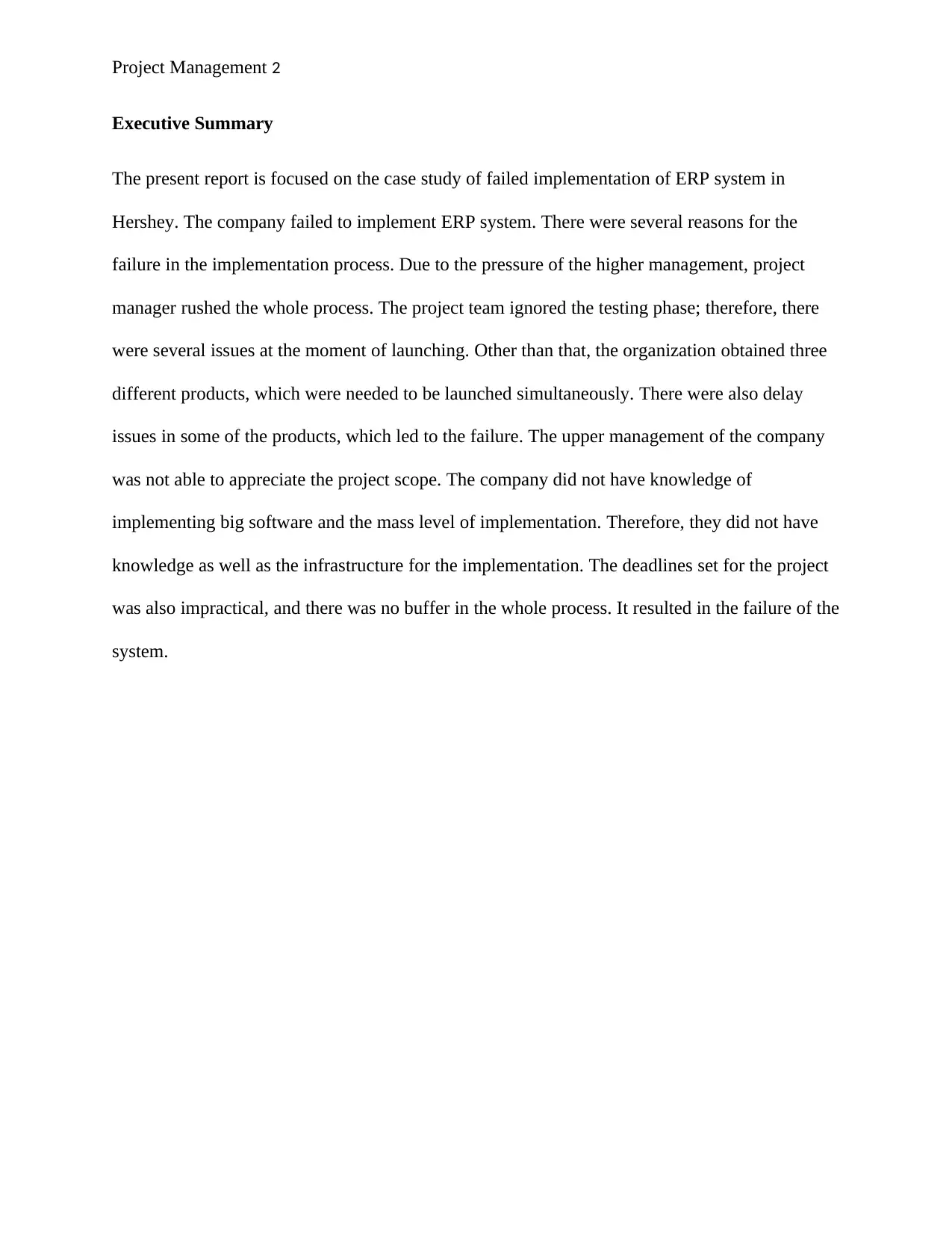
Project Management 2
Executive Summary
The present report is focused on the case study of failed implementation of ERP system in
Hershey. The company failed to implement ERP system. There were several reasons for the
failure in the implementation process. Due to the pressure of the higher management, project
manager rushed the whole process. The project team ignored the testing phase; therefore, there
were several issues at the moment of launching. Other than that, the organization obtained three
different products, which were needed to be launched simultaneously. There were also delay
issues in some of the products, which led to the failure. The upper management of the company
was not able to appreciate the project scope. The company did not have knowledge of
implementing big software and the mass level of implementation. Therefore, they did not have
knowledge as well as the infrastructure for the implementation. The deadlines set for the project
was also impractical, and there was no buffer in the whole process. It resulted in the failure of the
system.
Executive Summary
The present report is focused on the case study of failed implementation of ERP system in
Hershey. The company failed to implement ERP system. There were several reasons for the
failure in the implementation process. Due to the pressure of the higher management, project
manager rushed the whole process. The project team ignored the testing phase; therefore, there
were several issues at the moment of launching. Other than that, the organization obtained three
different products, which were needed to be launched simultaneously. There were also delay
issues in some of the products, which led to the failure. The upper management of the company
was not able to appreciate the project scope. The company did not have knowledge of
implementing big software and the mass level of implementation. Therefore, they did not have
knowledge as well as the infrastructure for the implementation. The deadlines set for the project
was also impractical, and there was no buffer in the whole process. It resulted in the failure of the
system.
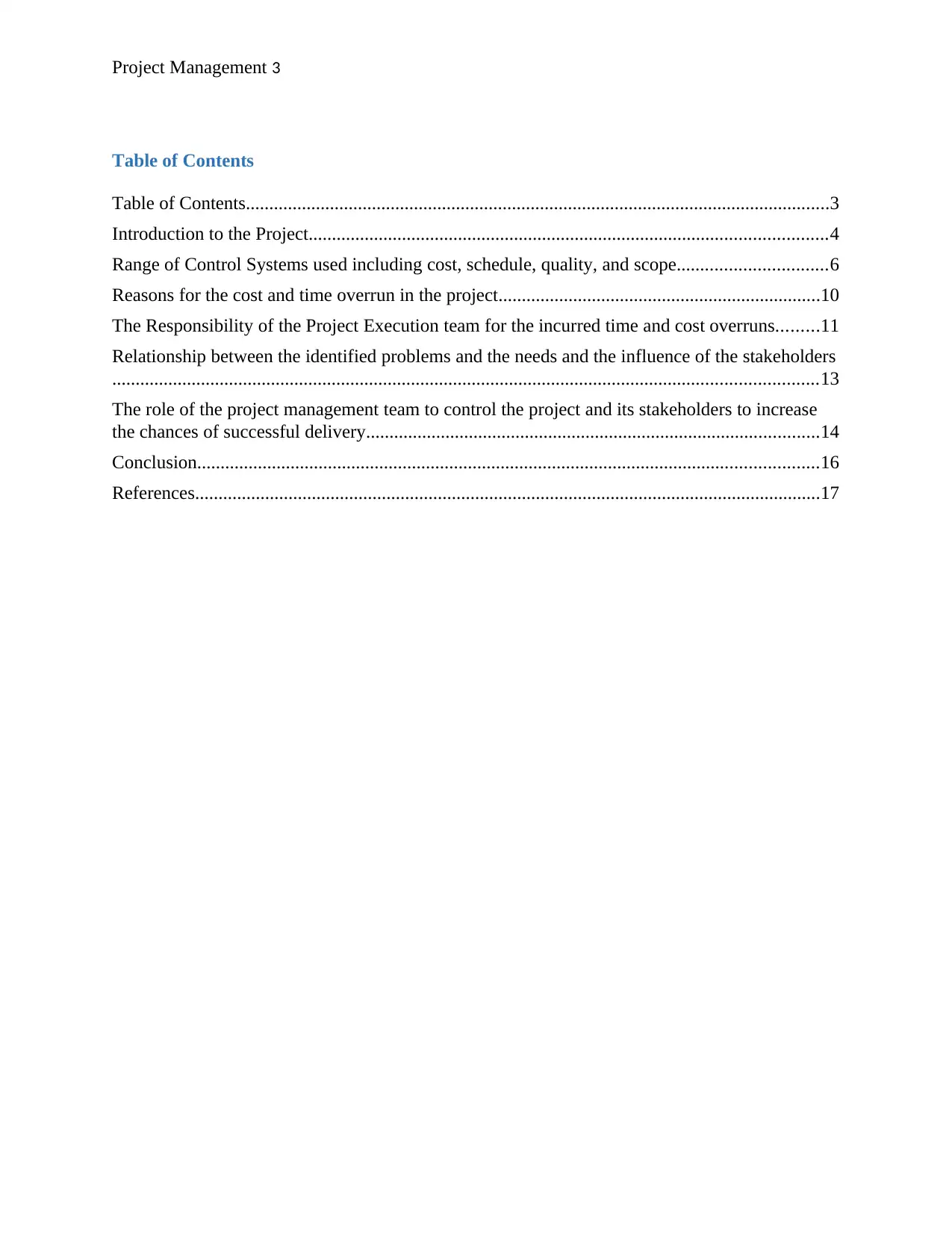
Project Management 3
Table of Contents
Table of Contents.............................................................................................................................3
Introduction to the Project...............................................................................................................4
Range of Control Systems used including cost, schedule, quality, and scope................................6
Reasons for the cost and time overrun in the project.....................................................................10
The Responsibility of the Project Execution team for the incurred time and cost overruns.........11
Relationship between the identified problems and the needs and the influence of the stakeholders
.......................................................................................................................................................13
The role of the project management team to control the project and its stakeholders to increase
the chances of successful delivery.................................................................................................14
Conclusion.....................................................................................................................................16
References......................................................................................................................................17
Table of Contents
Table of Contents.............................................................................................................................3
Introduction to the Project...............................................................................................................4
Range of Control Systems used including cost, schedule, quality, and scope................................6
Reasons for the cost and time overrun in the project.....................................................................10
The Responsibility of the Project Execution team for the incurred time and cost overruns.........11
Relationship between the identified problems and the needs and the influence of the stakeholders
.......................................................................................................................................................13
The role of the project management team to control the project and its stakeholders to increase
the chances of successful delivery.................................................................................................14
Conclusion.....................................................................................................................................16
References......................................................................................................................................17
⊘ This is a preview!⊘
Do you want full access?
Subscribe today to unlock all pages.

Trusted by 1+ million students worldwide
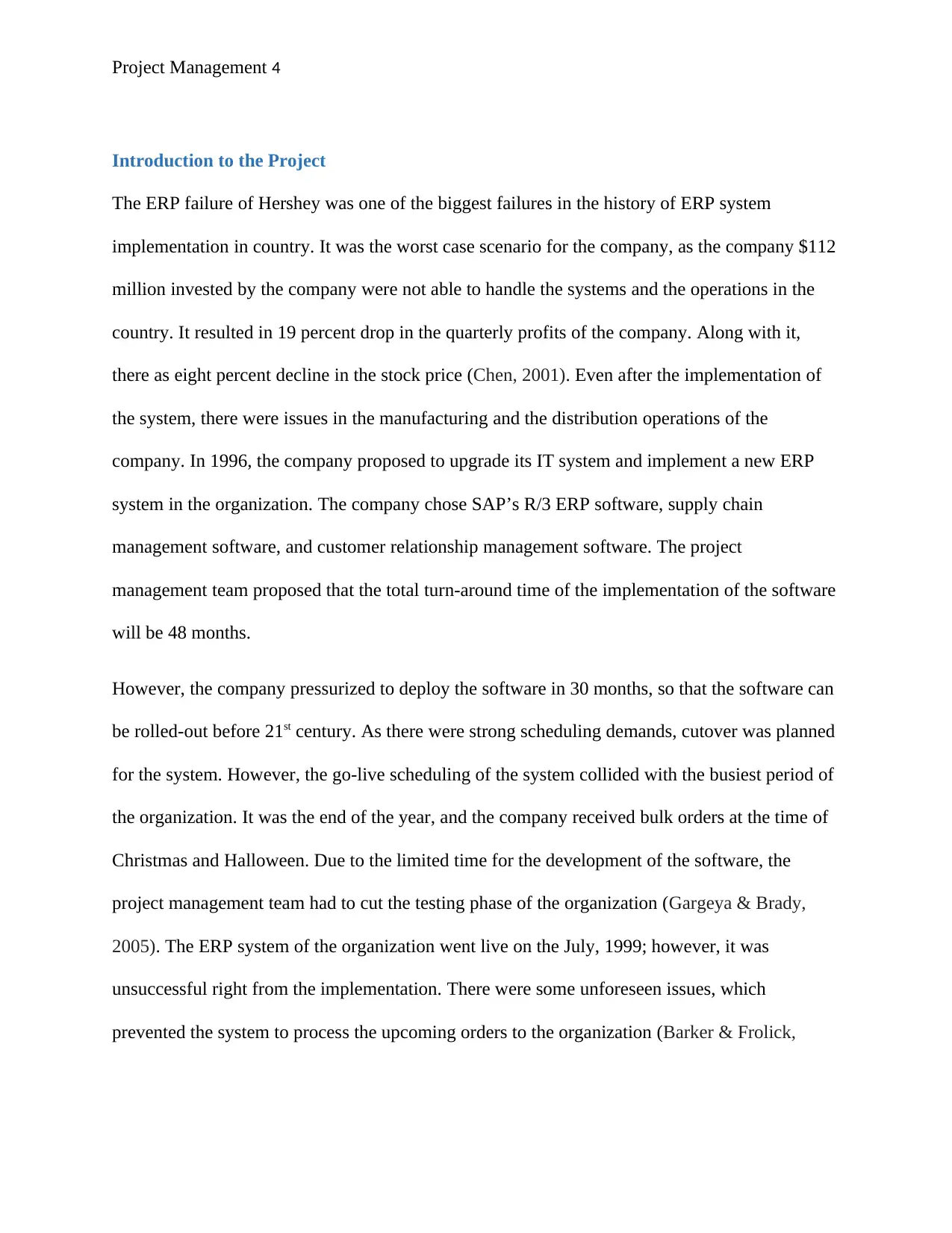
Project Management 4
Introduction to the Project
The ERP failure of Hershey was one of the biggest failures in the history of ERP system
implementation in country. It was the worst case scenario for the company, as the company $112
million invested by the company were not able to handle the systems and the operations in the
country. It resulted in 19 percent drop in the quarterly profits of the company. Along with it,
there as eight percent decline in the stock price (Chen, 2001). Even after the implementation of
the system, there were issues in the manufacturing and the distribution operations of the
company. In 1996, the company proposed to upgrade its IT system and implement a new ERP
system in the organization. The company chose SAP’s R/3 ERP software, supply chain
management software, and customer relationship management software. The project
management team proposed that the total turn-around time of the implementation of the software
will be 48 months.
However, the company pressurized to deploy the software in 30 months, so that the software can
be rolled-out before 21st century. As there were strong scheduling demands, cutover was planned
for the system. However, the go-live scheduling of the system collided with the busiest period of
the organization. It was the end of the year, and the company received bulk orders at the time of
Christmas and Halloween. Due to the limited time for the development of the software, the
project management team had to cut the testing phase of the organization (Gargeya & Brady,
2005). The ERP system of the organization went live on the July, 1999; however, it was
unsuccessful right from the implementation. There were some unforeseen issues, which
prevented the system to process the upcoming orders to the organization (Barker & Frolick,
Introduction to the Project
The ERP failure of Hershey was one of the biggest failures in the history of ERP system
implementation in country. It was the worst case scenario for the company, as the company $112
million invested by the company were not able to handle the systems and the operations in the
country. It resulted in 19 percent drop in the quarterly profits of the company. Along with it,
there as eight percent decline in the stock price (Chen, 2001). Even after the implementation of
the system, there were issues in the manufacturing and the distribution operations of the
company. In 1996, the company proposed to upgrade its IT system and implement a new ERP
system in the organization. The company chose SAP’s R/3 ERP software, supply chain
management software, and customer relationship management software. The project
management team proposed that the total turn-around time of the implementation of the software
will be 48 months.
However, the company pressurized to deploy the software in 30 months, so that the software can
be rolled-out before 21st century. As there were strong scheduling demands, cutover was planned
for the system. However, the go-live scheduling of the system collided with the busiest period of
the organization. It was the end of the year, and the company received bulk orders at the time of
Christmas and Halloween. Due to the limited time for the development of the software, the
project management team had to cut the testing phase of the organization (Gargeya & Brady,
2005). The ERP system of the organization went live on the July, 1999; however, it was
unsuccessful right from the implementation. There were some unforeseen issues, which
prevented the system to process the upcoming orders to the organization (Barker & Frolick,
Paraphrase This Document
Need a fresh take? Get an instant paraphrase of this document with our AI Paraphraser
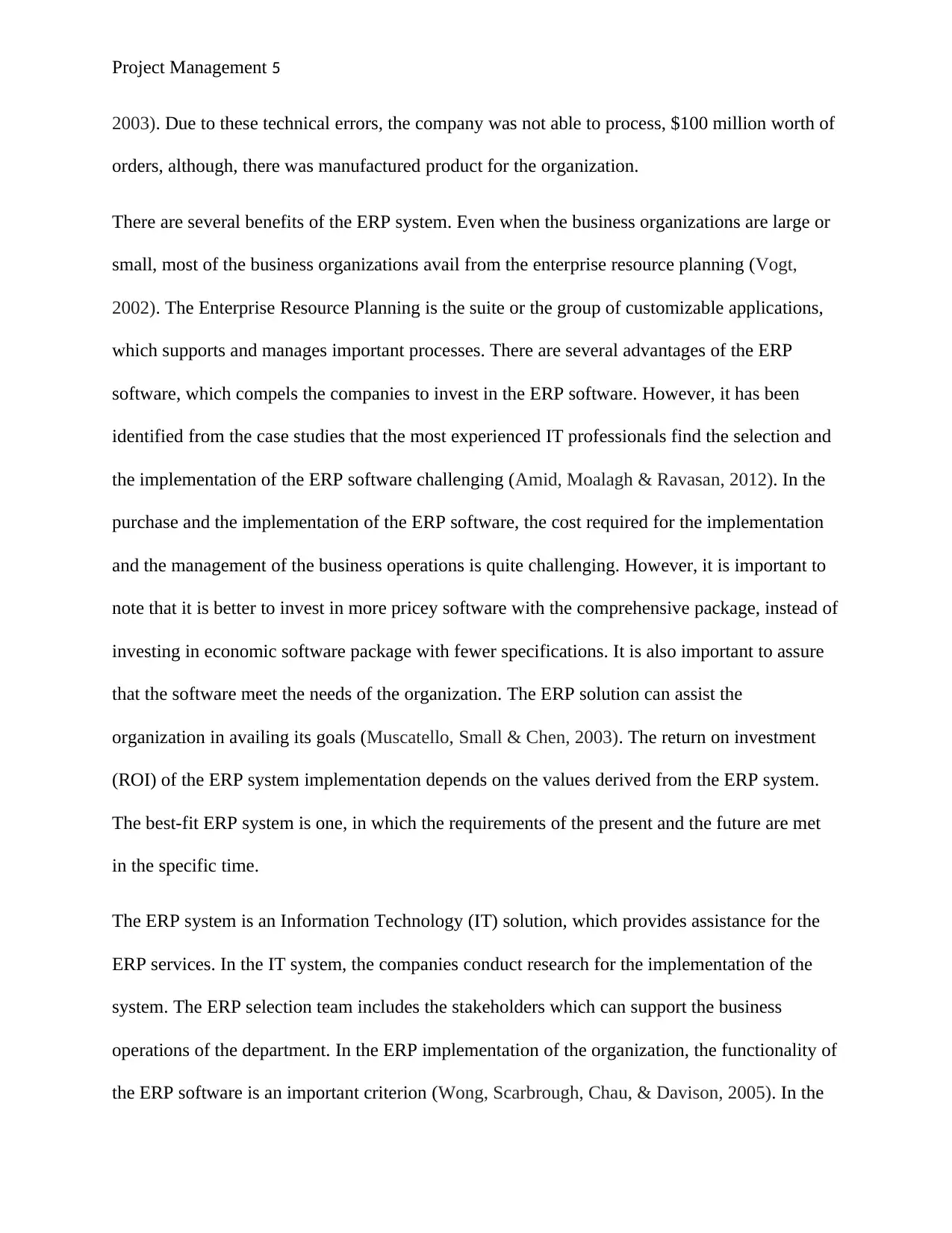
Project Management 5
2003). Due to these technical errors, the company was not able to process, $100 million worth of
orders, although, there was manufactured product for the organization.
There are several benefits of the ERP system. Even when the business organizations are large or
small, most of the business organizations avail from the enterprise resource planning (Vogt,
2002). The Enterprise Resource Planning is the suite or the group of customizable applications,
which supports and manages important processes. There are several advantages of the ERP
software, which compels the companies to invest in the ERP software. However, it has been
identified from the case studies that the most experienced IT professionals find the selection and
the implementation of the ERP software challenging (Amid, Moalagh & Ravasan, 2012). In the
purchase and the implementation of the ERP software, the cost required for the implementation
and the management of the business operations is quite challenging. However, it is important to
note that it is better to invest in more pricey software with the comprehensive package, instead of
investing in economic software package with fewer specifications. It is also important to assure
that the software meet the needs of the organization. The ERP solution can assist the
organization in availing its goals (Muscatello, Small & Chen, 2003). The return on investment
(ROI) of the ERP system implementation depends on the values derived from the ERP system.
The best-fit ERP system is one, in which the requirements of the present and the future are met
in the specific time.
The ERP system is an Information Technology (IT) solution, which provides assistance for the
ERP services. In the IT system, the companies conduct research for the implementation of the
system. The ERP selection team includes the stakeholders which can support the business
operations of the department. In the ERP implementation of the organization, the functionality of
the ERP software is an important criterion (Wong, Scarbrough, Chau, & Davison, 2005). In the
2003). Due to these technical errors, the company was not able to process, $100 million worth of
orders, although, there was manufactured product for the organization.
There are several benefits of the ERP system. Even when the business organizations are large or
small, most of the business organizations avail from the enterprise resource planning (Vogt,
2002). The Enterprise Resource Planning is the suite or the group of customizable applications,
which supports and manages important processes. There are several advantages of the ERP
software, which compels the companies to invest in the ERP software. However, it has been
identified from the case studies that the most experienced IT professionals find the selection and
the implementation of the ERP software challenging (Amid, Moalagh & Ravasan, 2012). In the
purchase and the implementation of the ERP software, the cost required for the implementation
and the management of the business operations is quite challenging. However, it is important to
note that it is better to invest in more pricey software with the comprehensive package, instead of
investing in economic software package with fewer specifications. It is also important to assure
that the software meet the needs of the organization. The ERP solution can assist the
organization in availing its goals (Muscatello, Small & Chen, 2003). The return on investment
(ROI) of the ERP system implementation depends on the values derived from the ERP system.
The best-fit ERP system is one, in which the requirements of the present and the future are met
in the specific time.
The ERP system is an Information Technology (IT) solution, which provides assistance for the
ERP services. In the IT system, the companies conduct research for the implementation of the
system. The ERP selection team includes the stakeholders which can support the business
operations of the department. In the ERP implementation of the organization, the functionality of
the ERP software is an important criterion (Wong, Scarbrough, Chau, & Davison, 2005). In the
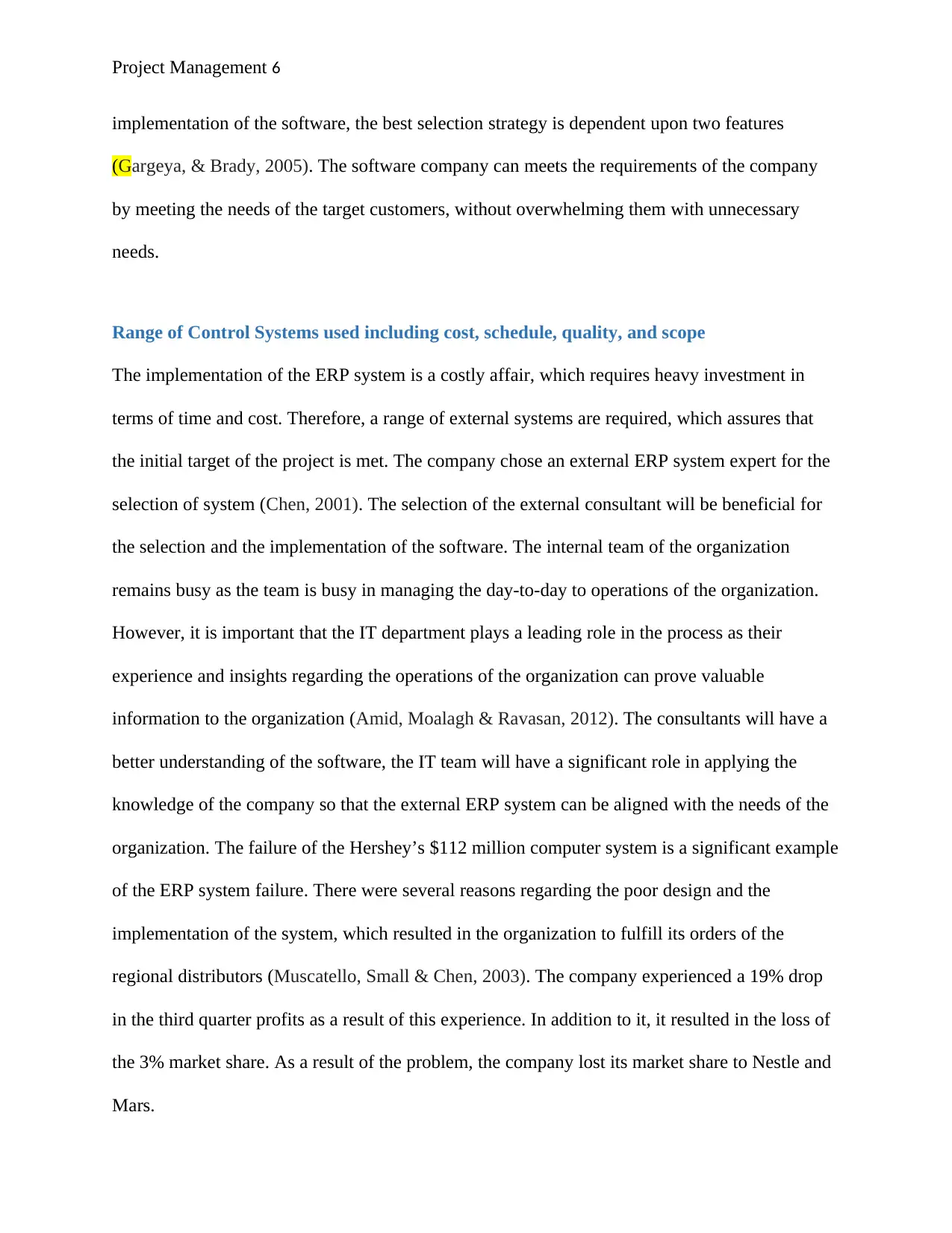
Project Management 6
implementation of the software, the best selection strategy is dependent upon two features
(Gargeya, & Brady, 2005). The software company can meets the requirements of the company
by meeting the needs of the target customers, without overwhelming them with unnecessary
needs.
Range of Control Systems used including cost, schedule, quality, and scope
The implementation of the ERP system is a costly affair, which requires heavy investment in
terms of time and cost. Therefore, a range of external systems are required, which assures that
the initial target of the project is met. The company chose an external ERP system expert for the
selection of system (Chen, 2001). The selection of the external consultant will be beneficial for
the selection and the implementation of the software. The internal team of the organization
remains busy as the team is busy in managing the day-to-day to operations of the organization.
However, it is important that the IT department plays a leading role in the process as their
experience and insights regarding the operations of the organization can prove valuable
information to the organization (Amid, Moalagh & Ravasan, 2012). The consultants will have a
better understanding of the software, the IT team will have a significant role in applying the
knowledge of the company so that the external ERP system can be aligned with the needs of the
organization. The failure of the Hershey’s $112 million computer system is a significant example
of the ERP system failure. There were several reasons regarding the poor design and the
implementation of the system, which resulted in the organization to fulfill its orders of the
regional distributors (Muscatello, Small & Chen, 2003). The company experienced a 19% drop
in the third quarter profits as a result of this experience. In addition to it, it resulted in the loss of
the 3% market share. As a result of the problem, the company lost its market share to Nestle and
Mars.
implementation of the software, the best selection strategy is dependent upon two features
(Gargeya, & Brady, 2005). The software company can meets the requirements of the company
by meeting the needs of the target customers, without overwhelming them with unnecessary
needs.
Range of Control Systems used including cost, schedule, quality, and scope
The implementation of the ERP system is a costly affair, which requires heavy investment in
terms of time and cost. Therefore, a range of external systems are required, which assures that
the initial target of the project is met. The company chose an external ERP system expert for the
selection of system (Chen, 2001). The selection of the external consultant will be beneficial for
the selection and the implementation of the software. The internal team of the organization
remains busy as the team is busy in managing the day-to-day to operations of the organization.
However, it is important that the IT department plays a leading role in the process as their
experience and insights regarding the operations of the organization can prove valuable
information to the organization (Amid, Moalagh & Ravasan, 2012). The consultants will have a
better understanding of the software, the IT team will have a significant role in applying the
knowledge of the company so that the external ERP system can be aligned with the needs of the
organization. The failure of the Hershey’s $112 million computer system is a significant example
of the ERP system failure. There were several reasons regarding the poor design and the
implementation of the system, which resulted in the organization to fulfill its orders of the
regional distributors (Muscatello, Small & Chen, 2003). The company experienced a 19% drop
in the third quarter profits as a result of this experience. In addition to it, it resulted in the loss of
the 3% market share. As a result of the problem, the company lost its market share to Nestle and
Mars.
⊘ This is a preview!⊘
Do you want full access?
Subscribe today to unlock all pages.

Trusted by 1+ million students worldwide
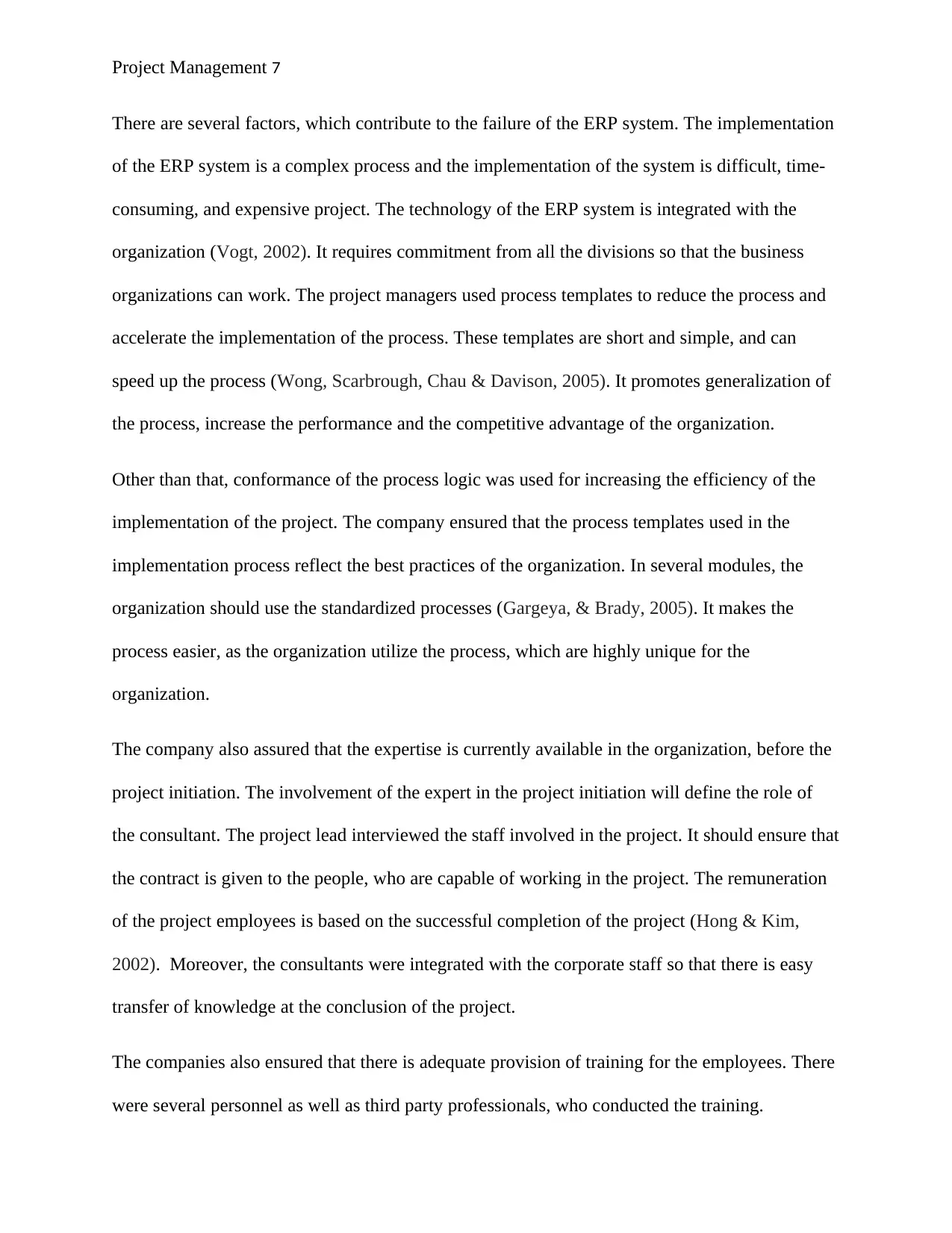
Project Management 7
There are several factors, which contribute to the failure of the ERP system. The implementation
of the ERP system is a complex process and the implementation of the system is difficult, time-
consuming, and expensive project. The technology of the ERP system is integrated with the
organization (Vogt, 2002). It requires commitment from all the divisions so that the business
organizations can work. The project managers used process templates to reduce the process and
accelerate the implementation of the process. These templates are short and simple, and can
speed up the process (Wong, Scarbrough, Chau & Davison, 2005). It promotes generalization of
the process, increase the performance and the competitive advantage of the organization.
Other than that, conformance of the process logic was used for increasing the efficiency of the
implementation of the project. The company ensured that the process templates used in the
implementation process reflect the best practices of the organization. In several modules, the
organization should use the standardized processes (Gargeya, & Brady, 2005). It makes the
process easier, as the organization utilize the process, which are highly unique for the
organization.
The company also assured that the expertise is currently available in the organization, before the
project initiation. The involvement of the expert in the project initiation will define the role of
the consultant. The project lead interviewed the staff involved in the project. It should ensure that
the contract is given to the people, who are capable of working in the project. The remuneration
of the project employees is based on the successful completion of the project (Hong & Kim,
2002). Moreover, the consultants were integrated with the corporate staff so that there is easy
transfer of knowledge at the conclusion of the project.
The companies also ensured that there is adequate provision of training for the employees. There
were several personnel as well as third party professionals, who conducted the training.
There are several factors, which contribute to the failure of the ERP system. The implementation
of the ERP system is a complex process and the implementation of the system is difficult, time-
consuming, and expensive project. The technology of the ERP system is integrated with the
organization (Vogt, 2002). It requires commitment from all the divisions so that the business
organizations can work. The project managers used process templates to reduce the process and
accelerate the implementation of the process. These templates are short and simple, and can
speed up the process (Wong, Scarbrough, Chau & Davison, 2005). It promotes generalization of
the process, increase the performance and the competitive advantage of the organization.
Other than that, conformance of the process logic was used for increasing the efficiency of the
implementation of the project. The company ensured that the process templates used in the
implementation process reflect the best practices of the organization. In several modules, the
organization should use the standardized processes (Gargeya, & Brady, 2005). It makes the
process easier, as the organization utilize the process, which are highly unique for the
organization.
The company also assured that the expertise is currently available in the organization, before the
project initiation. The involvement of the expert in the project initiation will define the role of
the consultant. The project lead interviewed the staff involved in the project. It should ensure that
the contract is given to the people, who are capable of working in the project. The remuneration
of the project employees is based on the successful completion of the project (Hong & Kim,
2002). Moreover, the consultants were integrated with the corporate staff so that there is easy
transfer of knowledge at the conclusion of the project.
The companies also ensured that there is adequate provision of training for the employees. There
were several personnel as well as third party professionals, who conducted the training.
Paraphrase This Document
Need a fresh take? Get an instant paraphrase of this document with our AI Paraphraser
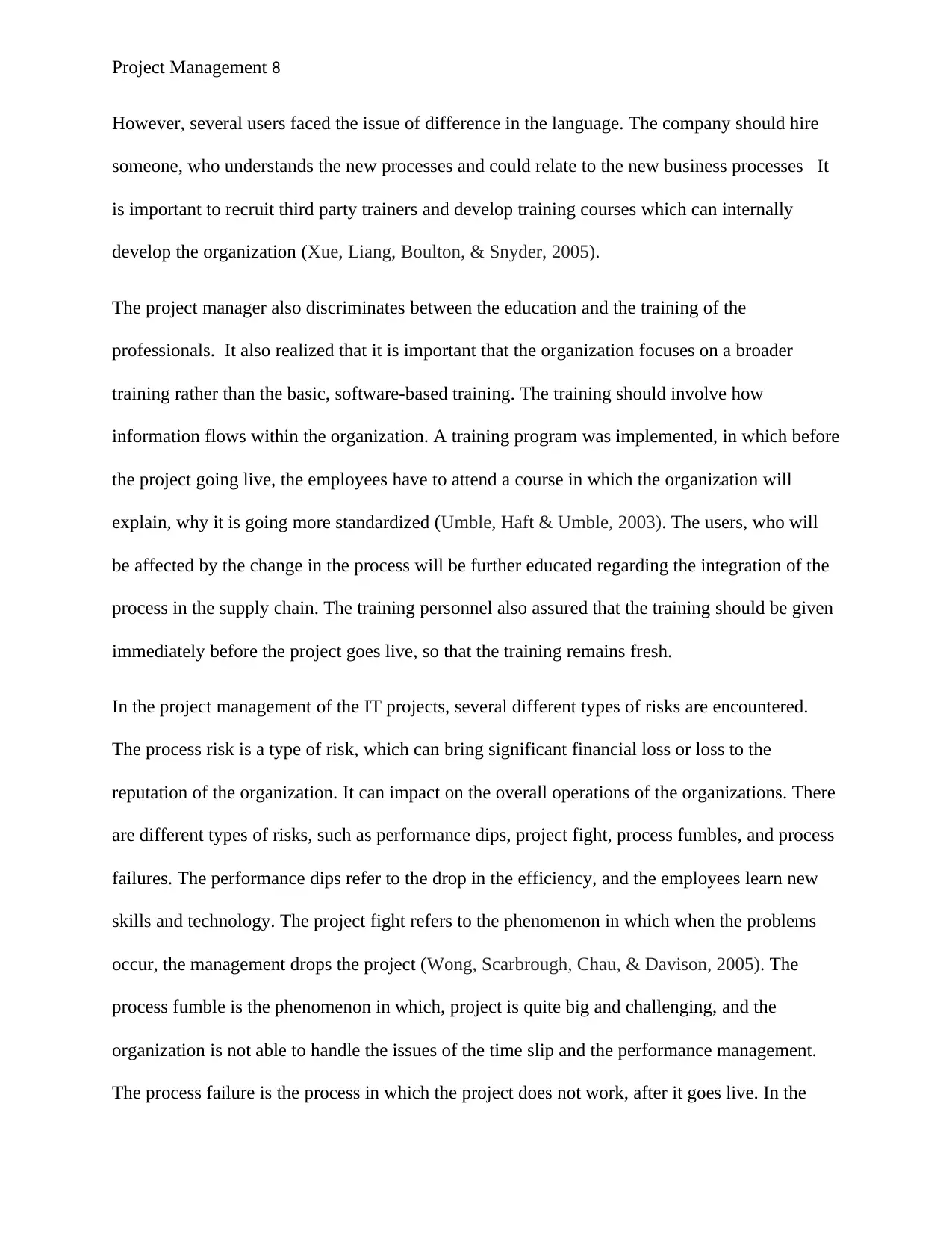
Project Management 8
However, several users faced the issue of difference in the language. The company should hire
someone, who understands the new processes and could relate to the new business processes It
is important to recruit third party trainers and develop training courses which can internally
develop the organization (Xue, Liang, Boulton, & Snyder, 2005).
The project manager also discriminates between the education and the training of the
professionals. It also realized that it is important that the organization focuses on a broader
training rather than the basic, software-based training. The training should involve how
information flows within the organization. A training program was implemented, in which before
the project going live, the employees have to attend a course in which the organization will
explain, why it is going more standardized (Umble, Haft & Umble, 2003). The users, who will
be affected by the change in the process will be further educated regarding the integration of the
process in the supply chain. The training personnel also assured that the training should be given
immediately before the project goes live, so that the training remains fresh.
In the project management of the IT projects, several different types of risks are encountered.
The process risk is a type of risk, which can bring significant financial loss or loss to the
reputation of the organization. It can impact on the overall operations of the organizations. There
are different types of risks, such as performance dips, project fight, process fumbles, and process
failures. The performance dips refer to the drop in the efficiency, and the employees learn new
skills and technology. The project fight refers to the phenomenon in which when the problems
occur, the management drops the project (Wong, Scarbrough, Chau, & Davison, 2005). The
process fumble is the phenomenon in which, project is quite big and challenging, and the
organization is not able to handle the issues of the time slip and the performance management.
The process failure is the process in which the project does not work, after it goes live. In the
However, several users faced the issue of difference in the language. The company should hire
someone, who understands the new processes and could relate to the new business processes It
is important to recruit third party trainers and develop training courses which can internally
develop the organization (Xue, Liang, Boulton, & Snyder, 2005).
The project manager also discriminates between the education and the training of the
professionals. It also realized that it is important that the organization focuses on a broader
training rather than the basic, software-based training. The training should involve how
information flows within the organization. A training program was implemented, in which before
the project going live, the employees have to attend a course in which the organization will
explain, why it is going more standardized (Umble, Haft & Umble, 2003). The users, who will
be affected by the change in the process will be further educated regarding the integration of the
process in the supply chain. The training personnel also assured that the training should be given
immediately before the project goes live, so that the training remains fresh.
In the project management of the IT projects, several different types of risks are encountered.
The process risk is a type of risk, which can bring significant financial loss or loss to the
reputation of the organization. It can impact on the overall operations of the organizations. There
are different types of risks, such as performance dips, project fight, process fumbles, and process
failures. The performance dips refer to the drop in the efficiency, and the employees learn new
skills and technology. The project fight refers to the phenomenon in which when the problems
occur, the management drops the project (Wong, Scarbrough, Chau, & Davison, 2005). The
process fumble is the phenomenon in which, project is quite big and challenging, and the
organization is not able to handle the issues of the time slip and the performance management.
The process failure is the process in which the project does not work, after it goes live. In the
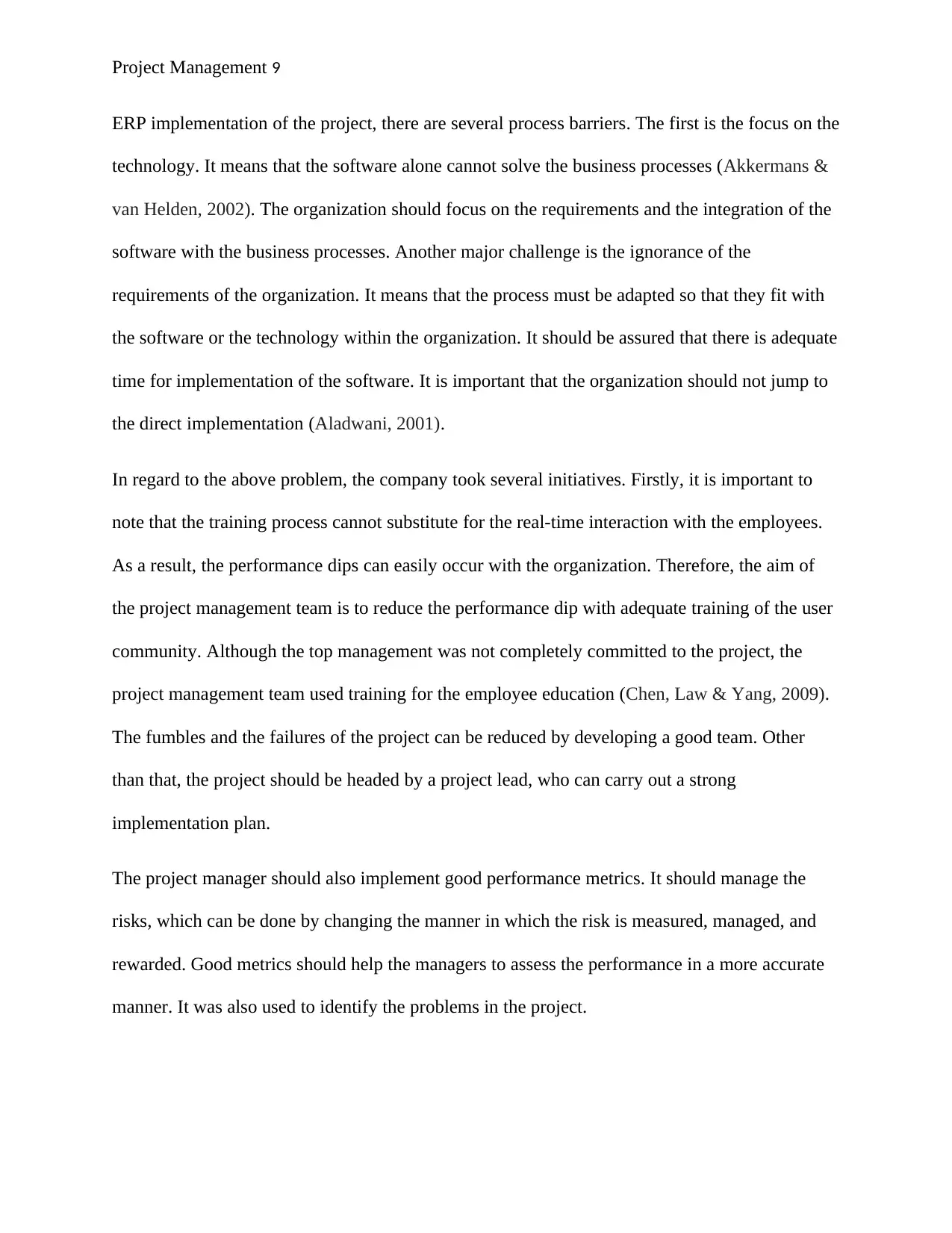
Project Management 9
ERP implementation of the project, there are several process barriers. The first is the focus on the
technology. It means that the software alone cannot solve the business processes (Akkermans &
van Helden, 2002). The organization should focus on the requirements and the integration of the
software with the business processes. Another major challenge is the ignorance of the
requirements of the organization. It means that the process must be adapted so that they fit with
the software or the technology within the organization. It should be assured that there is adequate
time for implementation of the software. It is important that the organization should not jump to
the direct implementation (Aladwani, 2001).
In regard to the above problem, the company took several initiatives. Firstly, it is important to
note that the training process cannot substitute for the real-time interaction with the employees.
As a result, the performance dips can easily occur with the organization. Therefore, the aim of
the project management team is to reduce the performance dip with adequate training of the user
community. Although the top management was not completely committed to the project, the
project management team used training for the employee education (Chen, Law & Yang, 2009).
The fumbles and the failures of the project can be reduced by developing a good team. Other
than that, the project should be headed by a project lead, who can carry out a strong
implementation plan.
The project manager should also implement good performance metrics. It should manage the
risks, which can be done by changing the manner in which the risk is measured, managed, and
rewarded. Good metrics should help the managers to assess the performance in a more accurate
manner. It was also used to identify the problems in the project.
ERP implementation of the project, there are several process barriers. The first is the focus on the
technology. It means that the software alone cannot solve the business processes (Akkermans &
van Helden, 2002). The organization should focus on the requirements and the integration of the
software with the business processes. Another major challenge is the ignorance of the
requirements of the organization. It means that the process must be adapted so that they fit with
the software or the technology within the organization. It should be assured that there is adequate
time for implementation of the software. It is important that the organization should not jump to
the direct implementation (Aladwani, 2001).
In regard to the above problem, the company took several initiatives. Firstly, it is important to
note that the training process cannot substitute for the real-time interaction with the employees.
As a result, the performance dips can easily occur with the organization. Therefore, the aim of
the project management team is to reduce the performance dip with adequate training of the user
community. Although the top management was not completely committed to the project, the
project management team used training for the employee education (Chen, Law & Yang, 2009).
The fumbles and the failures of the project can be reduced by developing a good team. Other
than that, the project should be headed by a project lead, who can carry out a strong
implementation plan.
The project manager should also implement good performance metrics. It should manage the
risks, which can be done by changing the manner in which the risk is measured, managed, and
rewarded. Good metrics should help the managers to assess the performance in a more accurate
manner. It was also used to identify the problems in the project.
⊘ This is a preview!⊘
Do you want full access?
Subscribe today to unlock all pages.

Trusted by 1+ million students worldwide
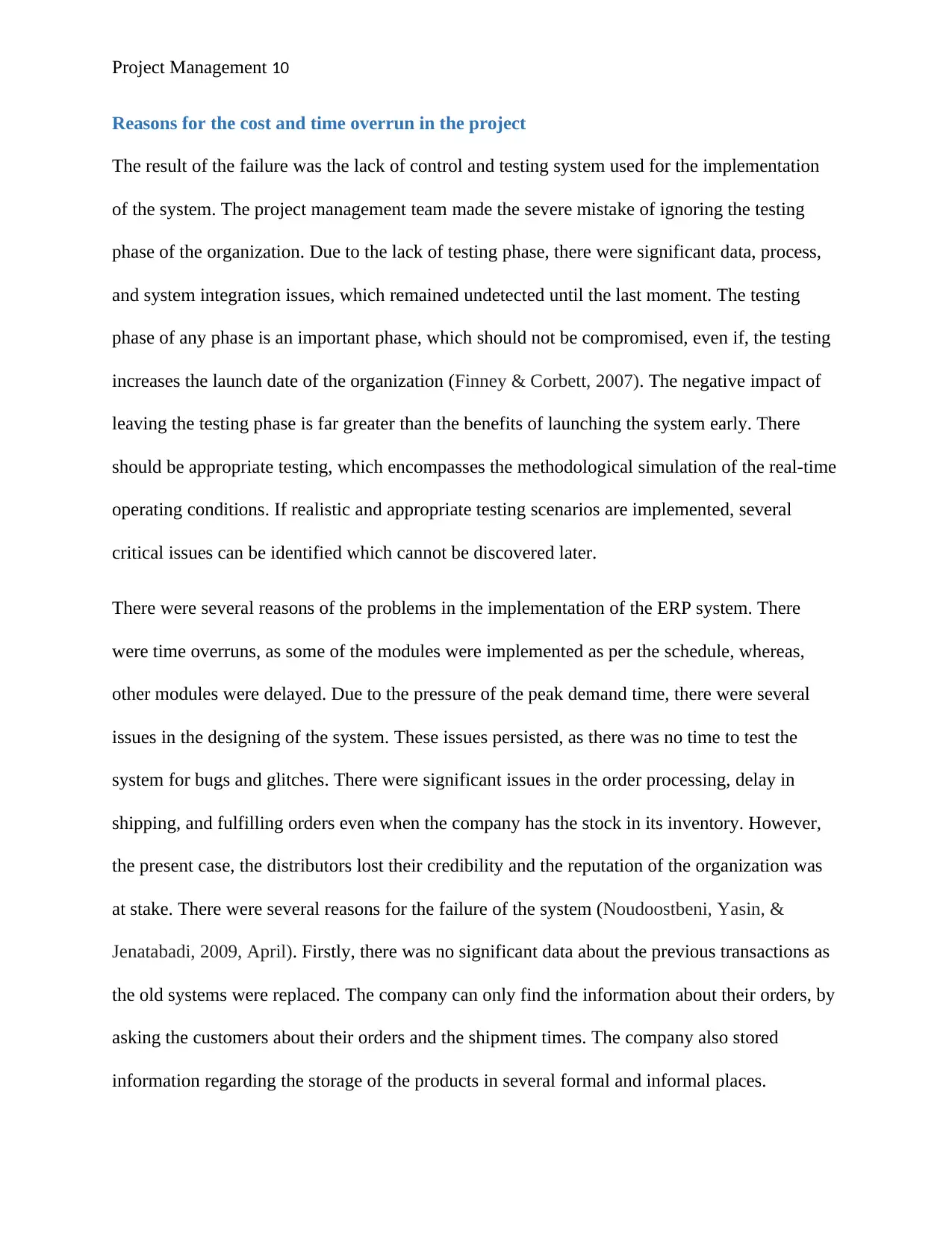
Project Management 10
Reasons for the cost and time overrun in the project
The result of the failure was the lack of control and testing system used for the implementation
of the system. The project management team made the severe mistake of ignoring the testing
phase of the organization. Due to the lack of testing phase, there were significant data, process,
and system integration issues, which remained undetected until the last moment. The testing
phase of any phase is an important phase, which should not be compromised, even if, the testing
increases the launch date of the organization (Finney & Corbett, 2007). The negative impact of
leaving the testing phase is far greater than the benefits of launching the system early. There
should be appropriate testing, which encompasses the methodological simulation of the real-time
operating conditions. If realistic and appropriate testing scenarios are implemented, several
critical issues can be identified which cannot be discovered later.
There were several reasons of the problems in the implementation of the ERP system. There
were time overruns, as some of the modules were implemented as per the schedule, whereas,
other modules were delayed. Due to the pressure of the peak demand time, there were several
issues in the designing of the system. These issues persisted, as there was no time to test the
system for bugs and glitches. There were significant issues in the order processing, delay in
shipping, and fulfilling orders even when the company has the stock in its inventory. However,
the present case, the distributors lost their credibility and the reputation of the organization was
at stake. There were several reasons for the failure of the system (Noudoostbeni, Yasin, &
Jenatabadi, 2009, April). Firstly, there was no significant data about the previous transactions as
the old systems were replaced. The company can only find the information about their orders, by
asking the customers about their orders and the shipment times. The company also stored
information regarding the storage of the products in several formal and informal places.
Reasons for the cost and time overrun in the project
The result of the failure was the lack of control and testing system used for the implementation
of the system. The project management team made the severe mistake of ignoring the testing
phase of the organization. Due to the lack of testing phase, there were significant data, process,
and system integration issues, which remained undetected until the last moment. The testing
phase of any phase is an important phase, which should not be compromised, even if, the testing
increases the launch date of the organization (Finney & Corbett, 2007). The negative impact of
leaving the testing phase is far greater than the benefits of launching the system early. There
should be appropriate testing, which encompasses the methodological simulation of the real-time
operating conditions. If realistic and appropriate testing scenarios are implemented, several
critical issues can be identified which cannot be discovered later.
There were several reasons of the problems in the implementation of the ERP system. There
were time overruns, as some of the modules were implemented as per the schedule, whereas,
other modules were delayed. Due to the pressure of the peak demand time, there were several
issues in the designing of the system. These issues persisted, as there was no time to test the
system for bugs and glitches. There were significant issues in the order processing, delay in
shipping, and fulfilling orders even when the company has the stock in its inventory. However,
the present case, the distributors lost their credibility and the reputation of the organization was
at stake. There were several reasons for the failure of the system (Noudoostbeni, Yasin, &
Jenatabadi, 2009, April). Firstly, there was no significant data about the previous transactions as
the old systems were replaced. The company can only find the information about their orders, by
asking the customers about their orders and the shipment times. The company also stored
information regarding the storage of the products in several formal and informal places.
Paraphrase This Document
Need a fresh take? Get an instant paraphrase of this document with our AI Paraphraser
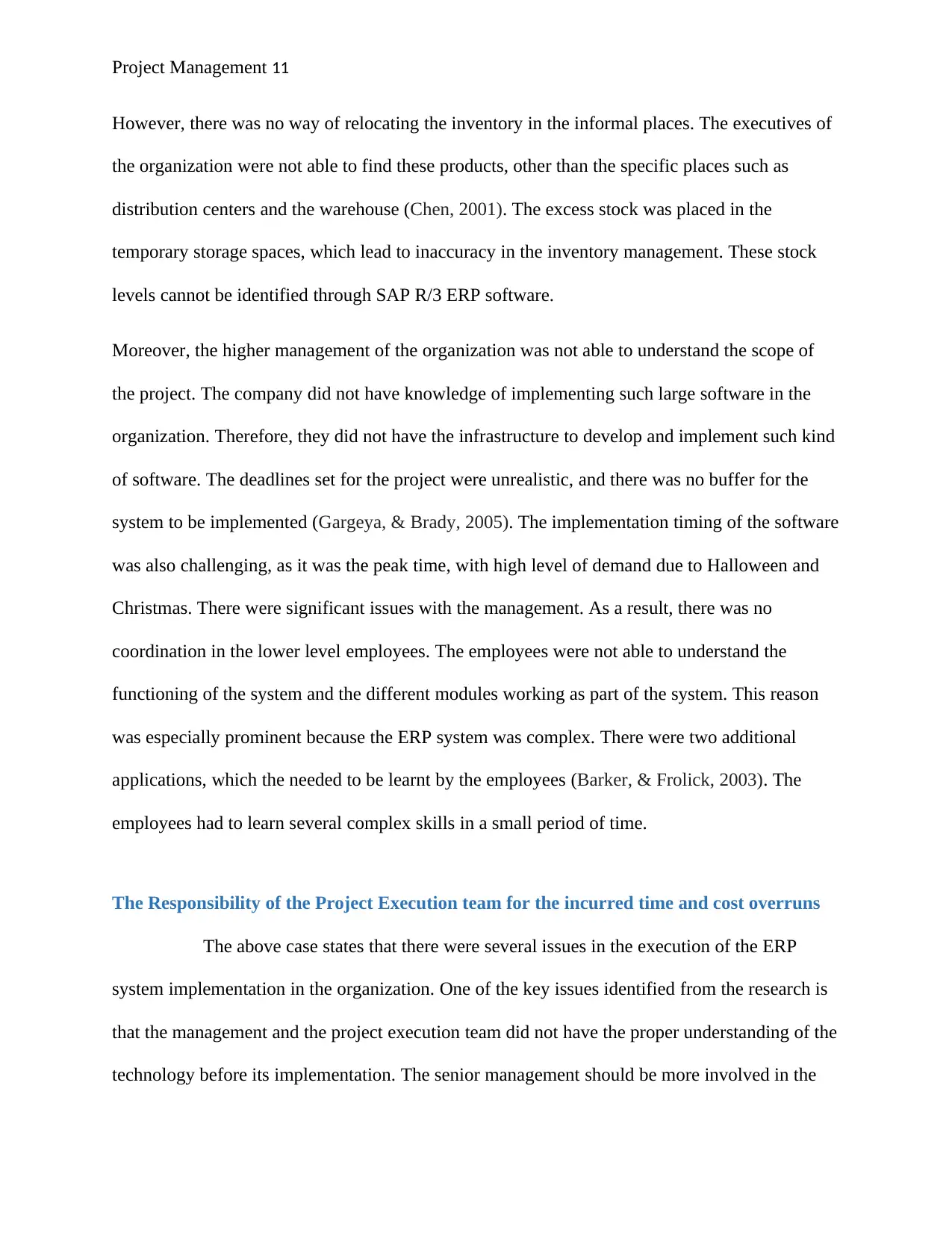
Project Management 11
However, there was no way of relocating the inventory in the informal places. The executives of
the organization were not able to find these products, other than the specific places such as
distribution centers and the warehouse (Chen, 2001). The excess stock was placed in the
temporary storage spaces, which lead to inaccuracy in the inventory management. These stock
levels cannot be identified through SAP R/3 ERP software.
Moreover, the higher management of the organization was not able to understand the scope of
the project. The company did not have knowledge of implementing such large software in the
organization. Therefore, they did not have the infrastructure to develop and implement such kind
of software. The deadlines set for the project were unrealistic, and there was no buffer for the
system to be implemented (Gargeya, & Brady, 2005). The implementation timing of the software
was also challenging, as it was the peak time, with high level of demand due to Halloween and
Christmas. There were significant issues with the management. As a result, there was no
coordination in the lower level employees. The employees were not able to understand the
functioning of the system and the different modules working as part of the system. This reason
was especially prominent because the ERP system was complex. There were two additional
applications, which the needed to be learnt by the employees (Barker, & Frolick, 2003). The
employees had to learn several complex skills in a small period of time.
The Responsibility of the Project Execution team for the incurred time and cost overruns
The above case states that there were several issues in the execution of the ERP
system implementation in the organization. One of the key issues identified from the research is
that the management and the project execution team did not have the proper understanding of the
technology before its implementation. The senior management should be more involved in the
However, there was no way of relocating the inventory in the informal places. The executives of
the organization were not able to find these products, other than the specific places such as
distribution centers and the warehouse (Chen, 2001). The excess stock was placed in the
temporary storage spaces, which lead to inaccuracy in the inventory management. These stock
levels cannot be identified through SAP R/3 ERP software.
Moreover, the higher management of the organization was not able to understand the scope of
the project. The company did not have knowledge of implementing such large software in the
organization. Therefore, they did not have the infrastructure to develop and implement such kind
of software. The deadlines set for the project were unrealistic, and there was no buffer for the
system to be implemented (Gargeya, & Brady, 2005). The implementation timing of the software
was also challenging, as it was the peak time, with high level of demand due to Halloween and
Christmas. There were significant issues with the management. As a result, there was no
coordination in the lower level employees. The employees were not able to understand the
functioning of the system and the different modules working as part of the system. This reason
was especially prominent because the ERP system was complex. There were two additional
applications, which the needed to be learnt by the employees (Barker, & Frolick, 2003). The
employees had to learn several complex skills in a small period of time.
The Responsibility of the Project Execution team for the incurred time and cost overruns
The above case states that there were several issues in the execution of the ERP
system implementation in the organization. One of the key issues identified from the research is
that the management and the project execution team did not have the proper understanding of the
technology before its implementation. The senior management should be more involved in the
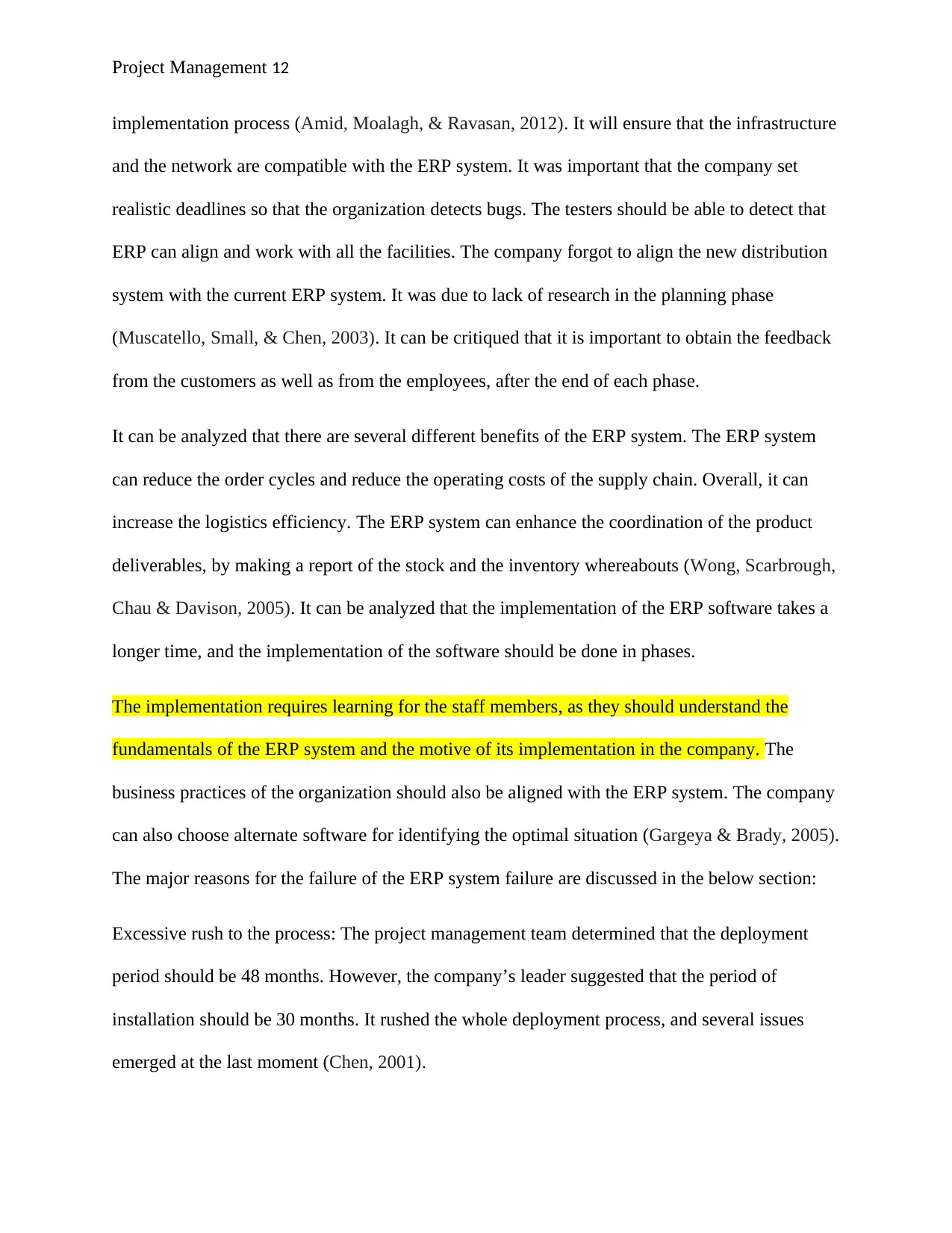
Project Management 12
implementation process (Amid, Moalagh, & Ravasan, 2012). It will ensure that the infrastructure
and the network are compatible with the ERP system. It was important that the company set
realistic deadlines so that the organization detects bugs. The testers should be able to detect that
ERP can align and work with all the facilities. The company forgot to align the new distribution
system with the current ERP system. It was due to lack of research in the planning phase
(Muscatello, Small, & Chen, 2003). It can be critiqued that it is important to obtain the feedback
from the customers as well as from the employees, after the end of each phase.
It can be analyzed that there are several different benefits of the ERP system. The ERP system
can reduce the order cycles and reduce the operating costs of the supply chain. Overall, it can
increase the logistics efficiency. The ERP system can enhance the coordination of the product
deliverables, by making a report of the stock and the inventory whereabouts (Wong, Scarbrough,
Chau & Davison, 2005). It can be analyzed that the implementation of the ERP software takes a
longer time, and the implementation of the software should be done in phases.
The implementation requires learning for the staff members, as they should understand the
fundamentals of the ERP system and the motive of its implementation in the company. The
business practices of the organization should also be aligned with the ERP system. The company
can also choose alternate software for identifying the optimal situation (Gargeya & Brady, 2005).
The major reasons for the failure of the ERP system failure are discussed in the below section:
Excessive rush to the process: The project management team determined that the deployment
period should be 48 months. However, the company’s leader suggested that the period of
installation should be 30 months. It rushed the whole deployment process, and several issues
emerged at the last moment (Chen, 2001).
implementation process (Amid, Moalagh, & Ravasan, 2012). It will ensure that the infrastructure
and the network are compatible with the ERP system. It was important that the company set
realistic deadlines so that the organization detects bugs. The testers should be able to detect that
ERP can align and work with all the facilities. The company forgot to align the new distribution
system with the current ERP system. It was due to lack of research in the planning phase
(Muscatello, Small, & Chen, 2003). It can be critiqued that it is important to obtain the feedback
from the customers as well as from the employees, after the end of each phase.
It can be analyzed that there are several different benefits of the ERP system. The ERP system
can reduce the order cycles and reduce the operating costs of the supply chain. Overall, it can
increase the logistics efficiency. The ERP system can enhance the coordination of the product
deliverables, by making a report of the stock and the inventory whereabouts (Wong, Scarbrough,
Chau & Davison, 2005). It can be analyzed that the implementation of the ERP software takes a
longer time, and the implementation of the software should be done in phases.
The implementation requires learning for the staff members, as they should understand the
fundamentals of the ERP system and the motive of its implementation in the company. The
business practices of the organization should also be aligned with the ERP system. The company
can also choose alternate software for identifying the optimal situation (Gargeya & Brady, 2005).
The major reasons for the failure of the ERP system failure are discussed in the below section:
Excessive rush to the process: The project management team determined that the deployment
period should be 48 months. However, the company’s leader suggested that the period of
installation should be 30 months. It rushed the whole deployment process, and several issues
emerged at the last moment (Chen, 2001).
⊘ This is a preview!⊘
Do you want full access?
Subscribe today to unlock all pages.

Trusted by 1+ million students worldwide
1 out of 19
Related Documents
Your All-in-One AI-Powered Toolkit for Academic Success.
+13062052269
info@desklib.com
Available 24*7 on WhatsApp / Email
![[object Object]](/_next/static/media/star-bottom.7253800d.svg)
Unlock your academic potential
Copyright © 2020–2025 A2Z Services. All Rights Reserved. Developed and managed by ZUCOL.




